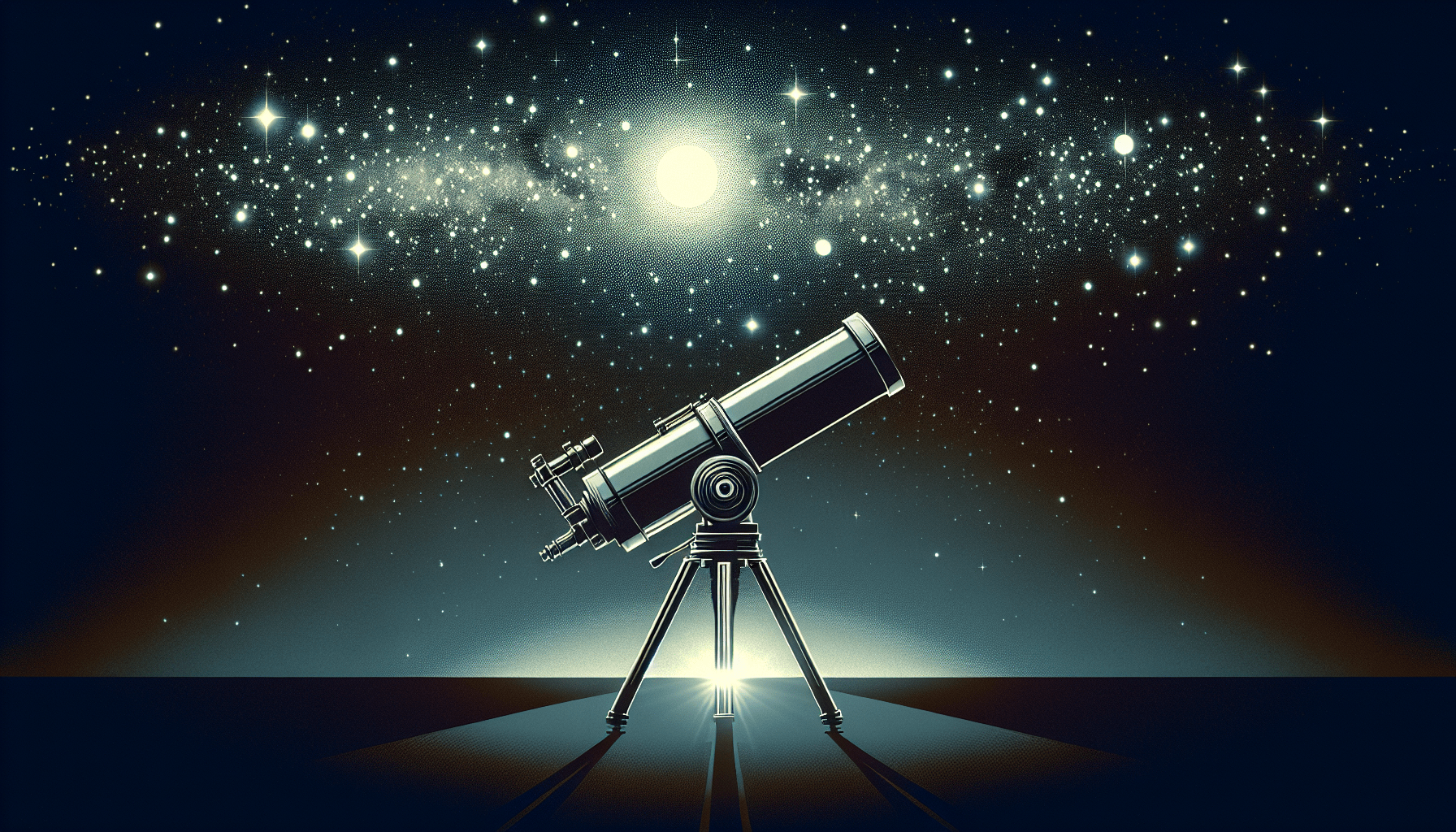How much should you spend on your first telescope? This question is crucial as you embark on your journey into stargazing and astronomy. Striking the right balance between quality and cost can make your experience both enjoyable and sustainable. You don’t want to over-invest on a sophisticated instrument if you’re just starting out, but you also don’t want to under-invest and end up with a telescope that offers poor performance, which can lead to frustration. This article will guide you through the factors to consider and shed light on how to determine the ideal budget for your first telescope.

This image is property of images.unsplash.com.
Table of Contents
Overview
Stargazing is an enchanting hobby, but it requires a bit of planning, especially when you’re choosing your first telescope. Your excitement might tempt you to buy the most expensive telescope out there, but it’s essential to make an informed decision. Telescopes vary greatly in terms of price, features, and complexity, and understanding these differences will help you set a realistic and effective budget.
Thesis Statement
Understanding how to determine the ideal budget for your first telescope is pivotal. This guide will walk you through the historical context, current trends, and key concepts to help you make an informed decision. Our goal is to ensure you invest wisely, so your stargazing journey is both fulfilling and sustainable.
Historical Context
Historically, telescopes have been expensive scientific instruments accessible to only a few. Ever since Galileo first pointed a telescope skyward in 1609, these instruments have evolved tremendously. Early telescopes were rudimentary and had limited magnification, but they revolutionized our understanding of the cosmos. Over centuries, advancements in technology have made telescopes more affordable and accessible to amateur astronomers. Today, even budget-friendly telescopes can offer impressive views, making the hobby of stargazing open to almost anyone.
Current Trends
In recent years, the market for amateur telescopes has seen a surge, thanks in part to growing interest in astronomy and increasing accessibility of high-quality telescopes at lower price points. Innovations like computerized telescopes and high-quality optics have made it easier for beginners to start their stargazing journey. There are beginner-friendly telescopes with features like automatic tracking of celestial objects, which used to be a luxury. These developments are beneficial, but they also add layers of complexity when choosing your first telescope.

This image is property of images.unsplash.com.
Key Concepts and Definitions
Types of Telescopes
Refractor Telescopes: These use lenses to focus light. They are generally known for their simplicity and reliability. A beginner might prefer them because they require less maintenance.
Reflector Telescopes: These use mirrors to gather and focus light. They are often more affordable compared to refractor telescopes with a similar aperture size but do require more maintenance.
Catadioptric Telescopes: These combine lenses and mirrors. They are versatile and portable, providing high-quality images, but can be more expensive.
Aperture
The aperture of a telescope is the diameter of the main lens or mirror. A larger aperture allows more light to enter the telescope, which means you can see fainter objects. Beginners might be tempted to get the largest aperture they can afford, but it’s essential to consider factors like portability and ease of use.
Magnification
Magnification is how much larger a telescope can make objects appear. While it might seem like the most important factor, magnification is actually less crucial than aperture. High magnification can result in blurry images if the aperture is too small.
Budget Considerations
Understanding Your Goals
Before setting a budget, consider what you expect from your telescope. Do you want to observe the Moon and planets, or are you more interested in deep-sky objects like galaxies and nebulae? Your goals will influence the type and power of the telescope you need.
Practical Budget Ranges
Here’s a simple breakdown of what you can expect within different budget ranges:
| Budget Range | Features & Considerations |
|---|---|
| Up to $100 | Basic telescopes; good for casual viewing of the Moon and some planets. Limited features. |
| $100-$300 | Entry-level telescopes; better optics, some automated features, suitable for beginners. |
| $300-$600 | Mid-range telescopes; enhanced features like motorized mounts, suitable for serious amateurs. |
| $600-$1000 | High-quality telescopes; excellent optics, advanced features, portable, versatile. |
| $1000+ | Premium telescopes; professional features, large apertures, for serious astronomers. |
Accessories
Don’t forget to budget for essential accessories like eyepieces, star charts, and perhaps a carrying case. These can significantly enhance your viewing experience but also add to the overall cost.

This image is property of images.unsplash.com.
Key Considerations for Beginners
Ease of Use
As a beginner, choose a telescope that’s easy to set up and use. Complicated instruments with steep learning curves can sap your enthusiasm. Reflector telescopes are relatively simple and provide excellent value for their aperture sizes, but they might require occasional maintenance like mirror collimation.
Portability
A bulky or heavy telescope can limit how often you use it. Consider where and how you’ll be transporting the telescope. Portability is crucial if you need to travel to dark-sky locations away from city lights.
Mount Type
Telescopes come with different types of mounts, mainly alt-azimuth and equatorial. For beginners, an alt-azimuth mount is often easier to use because it moves up, down, left, and right, like a camera tripod. An equatorial mount can track celestial objects as they move across the sky, but it is more complex to set up and use.
Example 1: The Pros and Cons of A Budget Telescope
Let’s take a look at a popular budget telescope, the Orion SkyScanner 100mm TableTop Reflector. Priced around $100, this model is an excellent entry-level telescope. It’s portable, easy to set up, and has a decent aperture for its price. It’s perfect for observing the Moon and planets but might struggle with faint deep-sky objects. This telescope represents a balanced approach for someone just starting and seeking to learn the basics without a significant financial commitment.

Example 2: Mid-Range Telescope Features
For those willing to invest a bit more, the Celestron NexStar 130SLT Computerized Telescope, priced at around $500, offers richer features. It’s a reflector telescope with a larger aperture, improving light gathering for better views of both planetary and deep-sky objects. The computerized mount with a built-in database of celestial objects can automatically locate and track them for you, making stargazing more enjoyable and less frustrating. This model highlights how additional investment can enhance the beginner’s experience.
Comparing Different Points of View
Choosing a telescope involves balancing several factors like cost, ease of use, and desired features. Here’s a comparison to help you understand different perspectives:
| Perspective | Budget Telescope | Mid-Range Telescope | High-End Telescope |
|---|---|---|---|
| Cost | Low cost, less financial risk | Moderate cost, reasonable investment | High cost, significant financial investment |
| Ease of Use | Simple, often fewer features | More features, slightly complex | Advanced features, steep learning curve |
| Optics Quality | Basic, adequate for Moon and planets | Better, versatile viewing options | Premium, can view faint deep-sky objects |
| Portability | Highly portable, small and compact | Portable, but larger than budget | Often bulky, heavy |
| Durability | May require frequent adjustments | More durable, occasional maintenance | Highly durable, built to last |

Impact Assessment
Budget Options
Budget telescopes make astronomy accessible to many but can sometimes result in buyer’s remorse due to their limitations. You might get a decent view of the Moon but struggle to see other celestial objects, leading to dissatisfaction.
Mid-Range Telescopes
Mid-range options strike a good balance. They provide better optics and features without breaking the bank. These telescopes are durable and versatile, making them a fantastic starting point for anyone serious about stargazing.
High-End Telescopes
High-end telescopes offer spectacular views and a wealth of features but come at a cost. Beginners might find them overwhelming or may not use many of the advanced features available. These are often better suited for those who are committed to the hobby.
Future Directions and Implications
Predictions
Technological advancements will likely continue to drive down costs and improve the quality and features of telescopes. Innovations like smarter computerized mounts, enhanced optics, and integration with smartphone apps will make astronomy even more accessible.
Implications for Amateur Astronomy
As telescopes become more advanced yet affordable, a new wave of amateur astronomers will emerge. These hobbyists will not only appreciate celestial wonders but also contribute to citizen science, tracking and reporting astronomical events.
Conclusion
In summary, determining the ideal budget for your first telescope involves understanding what you want from the telescope, the types available, and balancing cost with features. From budget-friendly options like the Orion SkyScanner to mid-range models like the Celestron NexStar, there’s a telescope for you. The decision is personal and depends on several factors, but with the right information, you can embark on a rewarding stargazing journey.
To sum up our discussion, investing in your first telescope is about making an informed decision tailored to your needs and budget. The right telescope can make a world of difference in your stargazing experience. What’s your perspective on balancing cost and features when buying your first telescope?
Feel free to explore more articles and guides on our site for further insights into making the most of your astronomy adventures.
